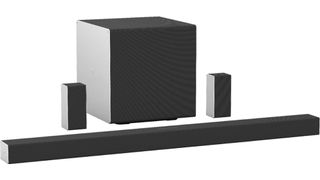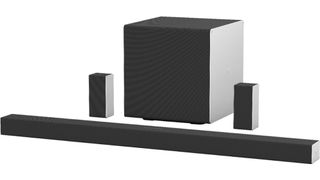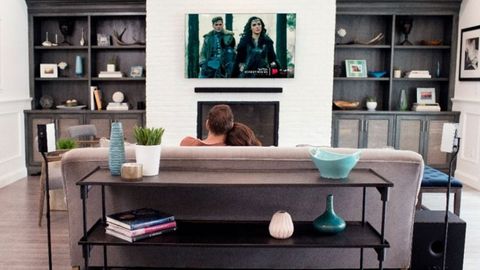TechRadar Verdict
While it’s a definite step-up in performance compared to Vizio’s 36-inch Atmos Soundbar, the SB46514-F6 is still missing some key features like a visible display on the soundbar, built-in noise leveling and better audio processing. It offers Atmos at a decent price, sure, but its audio performance still has some room to improve.
Pros
- +
Upfiring rear speakers
- +
SmartCast platform
- +
Powerful sub
Cons
- -
So-so surround system
- -
No display window
- -
Needs better audio processing
Why you can trust TechRadar
For whatever reason, 2018 wasn’t a great year for soundbars. Sure, there were a few winners in the bunch, but compared to the treasure trove of outstanding audio that we got in 2017, 2018 sort of paled in comparison.
But in what was a rather drab year for the form factor, Vizio’s two soundbars - the SB36512-F6 and SB46514-F6, reviewed here - were among two of the highlights, due to their inclusion of Dolby Atmos and SmartCast.
Are two technologies enough to justify this $999 (about £780, AU$1,400) soundbar? Unfortunately the answer's complicated.

Design
Vizio’s bigger Dolby Atmos soundbar measures in at 46-inches across and 2.5-inches high. Its low profile allows it to slide under most TVs with ease and shouldn’t block the IR receiver of TVs above 55-inches in size.
Inside the soundbar you’ll find five drivers set in a left, right, center and height-left, height-right configuration which give you a 3.0.2 setup by themselves. Add in the beastly subwoofer and rear satellites and you’ll have a full 5.1.4 system.
What separates the SB46514-F6 from its little brother is that the rear wireless channels have upfiring speakers of their own that add to the immersiveness of the surround sound, plus the subwoofer goes from a manageable 10 pounds to more like 25. That larger subwoofer allows this system to hit even lower bass frequencies and packs a wallop.
Like the other soundbar systems in Vizio’s 2018 series, the subwoofer and rear speakers don’t need to be connected physically to the main soundbar and instead only need to be connected to one another via two long cables - one for each speaker. These cables carry both power and signal and make it so that even the most novice of AV enthusiasts can get up and running in no time.
On the back of the soundbar, you’ll find an HDMI Out (ARC), HDMI IN, Optical Audio In and 3.5mm jack ports for audio, plus a USB and Ethernet port. On the front of the soundbar you’ll find, well, you won’t find anything other than a few LED indicator lights that flash to tell you what’s happening. It’d be nice if Vizio included a small LCD screen on the front, but there is one on the remote itself if memorizing LED patterns isn’t up your alley.

Features
The two marquee features of Vizio’s 2018 soundbars are its inclusion of Dolby Atmos audio and its Google Cast-based SmartCast system.
Now SmartCast, if you’re unfamiliar with it, is just Vizio’s name for its smart platform. It uses SmartCast on its TVs that has a visual component and it also uses SmartCast on its soundbars that’s basically identical to a Google Chromecast Audio.
What SmartCast allows you to do is send audio streams from your phone to your soundbar. Support currently includes apps like Pandora and Spotify, alongside a few of the other major players.
Having Chromecast built-in is a huge time saver - as long as your phone and the soundbar are on the same network, you can send an audio stream from one to the other without needing to manually connect over Bluetooth. Technically speaking, SmartCast doesn’t even need a constant connection to your phone to work - once your phone initiates the stream for SmartCast, the soundbar will use its internal Wi-Fi antenna to take over, allowing you to use your phone without an app hogging all your bandwidth.
While SmartCast makes streaming audio easier, Dolby Atmos is what makes audio sound better.
Atmos, if you’ve never heard it before, is the next step on the path to more realistic-sounding audio. Instead of five channels of discrete audio, Atmos provides four additional height channels to create a audio sphere where audio can occur both above and behind you.
Playing Atmos requires both content and a source - either an LG, Sony, TCL or Vizio TV, an Atmos-capable Blu-ray player, Xbox One or an Apple TV. Once you have Atmos content on an Atmos compatible system, the lower LEDs will light up green to indicate you’re hearing Atmos - you know, if you can’t tell by the sound of the helicopter flying overhead.

Performance
After reviewing the 36-inch Vizio Soundbar last month, we didn’t expect to hear much of a difference in the 46-inch version. We knew it’d be more powerful, obviously, but couldn’t picture much else changing. Thankfully, we were wrong.
The good news is that there’s a pretty sizable difference in sound quality from the 36-inch bar to the 46-inch version - the latter is not only louder, but it has a deeper bass response, a more forward mid-range and better sound dispersion that allows you to fill the room with high-quality sound rather than just a feet.
A vast majority of that is due to the fact that the soundbar itself has EIGHT drivers and two passive radiators that are in charge of outputting the left, right and center channels, as well as the height left and height right channels. Sound from the bar is beautiful, crisp and clear, but it really overpowers the significantly smaller rear speakers.
That said, while the additional height channels on the rear wireless speakers did add some extra immersion to Atmos sound, the upfiring rear drivers aren’t used for regular 5.1 content. That means the rear channels still don’t have a lot presence in the overall sound, and ultimately fail to deliver that Dolby Cinema experience that we’ve heard on other multi-channel setups.
The more significant problem, and the one you’ll run into more likely if you’re using it in tandem with a Vizio TV, is that the soundbar ramps up in volume with each little tick representing a significant boost in volume - a problem called volume ramping. Because there’s little-to-no volume leveling built into the soundbar (it has to be done through the Vizio TV) some content is room-shaking at around an 8 volume level, while most of the time 20 is enough to get the neighbors knocking on your door.
According to Vizio, some of these problems like adding extra oomph to the rear speakers can be changed on the soundbar while others - like volume ramping - are the way they are.
That said, it’s clear from testing that Vizio isn’t doing a ton of audio processing on the soundbar itself. Where other manufacturers are getting more clever about artificially expanding the soundstage using psychoacoustics or using processors to upscale low bitrate audio, Vizio’s soundbar is more upfront in its offering.
Final verdict
The SB46514-F6 is a step in the right direction for Vizio. It offers a wide sweet spot for a low-profile 46-inch soundbar and packs in both Dolby Atmos and SmartCast into well-rounded package.
Unfortunately, however, you’re paying a lot of money (around $900) for a soundbar that doesn’t do a ton of audio processing. It's also missing an LCD screen on the soundbar itself and the rear-firing speakers aren’t as powerful as we’d like at this price point.
If you need a high-powered, multi-channel soundbar with a dash of Dolby Atmos tossed in, this is a solid choice. Otherwise, there are other bars out there that are cheaper and offer a bit more in terms of audio processing.
- These are the best soundbars of 2019
Nick Pino is Managing Editor, TV and AV for TechRadar's sister site, Tom's Guide. Previously, he was the Senior Editor of Home Entertainment at TechRadar, covering TVs, headphones, speakers, video games, VR and streaming devices. He's also written for GamesRadar+, Official Xbox Magazine, PC Gamer and other outlets over the last decade, and he has a degree in computer science he's not using if anyone wants it.


